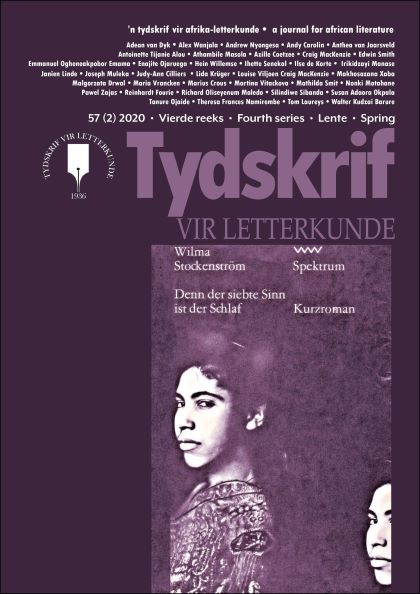La femme et le mariage: du mot à l’image—Xala d’Ousmane Sembene
DOI :
https://doi.org/10.17159/tl.v57i2.7967Mots-clés :
Ousmane Sembene, Xala, women, marriage, literacy techniques, cinematic techniquesRésumé
Published as a novel in 1973 and released as a film in 1974, Ousmane Sembene’s Xala offers his readers as well as his audience the most detailed display of one of his prominent themes: the role of women in marriage. This article examines how Sembene skilfully uses both literature and film to express the same theme and, in so doing, exploits each medium’s strong points to complement each other in order to reinforce the message he wishes to convey. Sembene, the modern griot, knows that life is complex, and, in his written work, he includes exceptions and nuances, which he is unable to highlight in his film due to time constraints. In so doing, his novel reflects a more detailed depiction of reality. By contrast, in his cinematic version, he focuses on certain aspects of the novel and amplifies them with the aid of cinematic techniques. As a result, he transcends the abstract and superficial distinctions made between the traditional woman and the westernised woman to create a more nuanced and striking message where not all women are described as being victims of polygamy and some of them go as far as opposing it. He shows the audience the negative as well as the positive aspects of polygamy, thus attaining his aim, which is to educate his people.
Téléchargements
Références
Adesokan, Akinwumi. “Fitful Decolonization: Xala and the Poetics of Double Fetishism.” Postcolonial Artists and Global Aesthetics, dirigé par Akinwumi Adesokan. Indiana U P, 2011, pp. 57–80.
Ashbury, Roy, et al. Teaching African Cinema. British Film Institute, 1998.
Binet, Jacques. “Le langage des cinéastes africains.” Cinémaction no. 26, 1983, pp. 84–9.
Case, Frederick I. “Aesthetics, ideology and social commitment in the prose fiction of Ousmane Sembene.” Ousmane Sembène. Dialogues with Critics and Writers, dirigé par Samba Gadjigo, et al. U of Massachusetts P, 1993, pp. 3–13.
Coulson, Noel & Doreen Hinchcliffe. “Women and law reform in contemporary Islam.” Women in the Muslim World, dirigé par Lois Beck & Nikki Keddie. Harvard U P, 1978, pp. 37–51.
Denny, Frederick. An Introduction to Islam. Macmillan & Collier Macmillan, 1985.
Diang’a, Rachel. “Trans-Formal Aesthetics and Cultural Impact on Ousmane Sembène’s Explication of Xala.” Sembene Ousmane and the Politics of Culture, dirigé par Lifongo Vetinde & Amadou Fofana. Lexington, 2014, pp. 145–56.
Diop, Abdoulaye B. “La polygamie au Sénégal.” L’Afrique Littéraire no. 76, 1985, pp. 51–4.
Gugler, Josef & Oumar C. Diop. “Ousmane Sembène’s Xala: The Novel, the Film and Their Audiences.” Research in African Literatures vol. 29, no. 2, 1998, pp. 147–8.
Harrow, Kenneth. “Sembène Ousmane’s Xala: The Use of Film and Novel as Revolutionary Weapon.” Studies in 20th Century Literature vol. 4, issue 2, 1980, pp. 177–88.
Ijere, Muriel. “La condition féminine dans Xala de Sembène Ousmane.” L’Afrique Littéraire no. 85, 1989, pp. 25–34.
Le Saint Coran, texte arabe et traduction française. Islam International, 2012.
Macrae, Susan. “The mature and older women of African film.” African Cinema: Postcolonial and Feminist Reading, dirigé par Kenneth Harrow. Africa World, 1999, pp. 242–54.
Metz, Christian. Essais sur la signification au cinéma. Klincksieck, 1983.
Moore, Carrie. Evolution of an African Artist: Social Realism in the Works of Ousmane Sembene. Indiana U P, 1973.
Murphy, David. Sembene—Imagining Alternatives in Film and Fiction. James Currey, 2000.
Nazhat, Afza & Ahmad Khurshid. The Position of Woman in Islam. Islamic Book, 1982.
Niang, Mamadou. “Still, the Fire in the Belly: The Confessions of Ousmane Sembene.” https://africanfilmny.org/articles/still-the-fire-in-the-belly-the-confessions-of-ousmane-sembene-an-interview-exclusive/.
Ortova, Jamila. “Les femmes dans l’œuvre littéraire d’Ousmane Sembène. ” Présence Africaine no. 71, 1969, pp. 69–77.
Petty, Shelia. “Towards a changing Africa: women’s roles in the films of Ousmane Sembene.” A Call to Action—The Films of Ousmane Sembene, dirigé par Shelia Petty. Flick, 1996, pp. 67–86.
Pfaff, Françoise. “Three Faces of Africa: Women in Xala.” Jump Cut: A Review of Contemporary Media no. 27, 1982, pp. 27–31.
Sembene, Ousmane. Xala. Présence Africaine, 1979.
Sembene, Ousmane. Xala. Sénégal, 1975. 117 minutes. (Version originale wolof, sous-titré en français).
Tcheuyap, Alexie. “Représentations du Féminin.” De l’écrit à l’écran: Les réécritures filmiques du roman africain francophone, dirigé par Alexie Tcheuyap. U Ottawa P, 2005, pp. 153–70.
Thackway, Melissa. Africa Shoots Back—Alternative perspectives in Sub-Saharan Francophone African Film. James Currey, 2003.
Trimingham, John S. The Influence of Islam upon Africa. Green, 1968.
Wynchank, Anny. “Le roman du film Guelwaar de Sembène Ousmane.” Carnets du Cerpanac, no. 2. 2002, pp. 131–42.
Téléchargements
Publiée
Numéro
Rubrique
Licence
(c) Copyright Tydskrif vir Letterkunde 2020

Ce travail est disponible sous licence Creative Commons Attribution - Partage dans les Mêmes Conditions 4.0 International.


 https://orcid.org/0000-0001-6465-6584
https://orcid.org/0000-0001-6465-6584


.png)